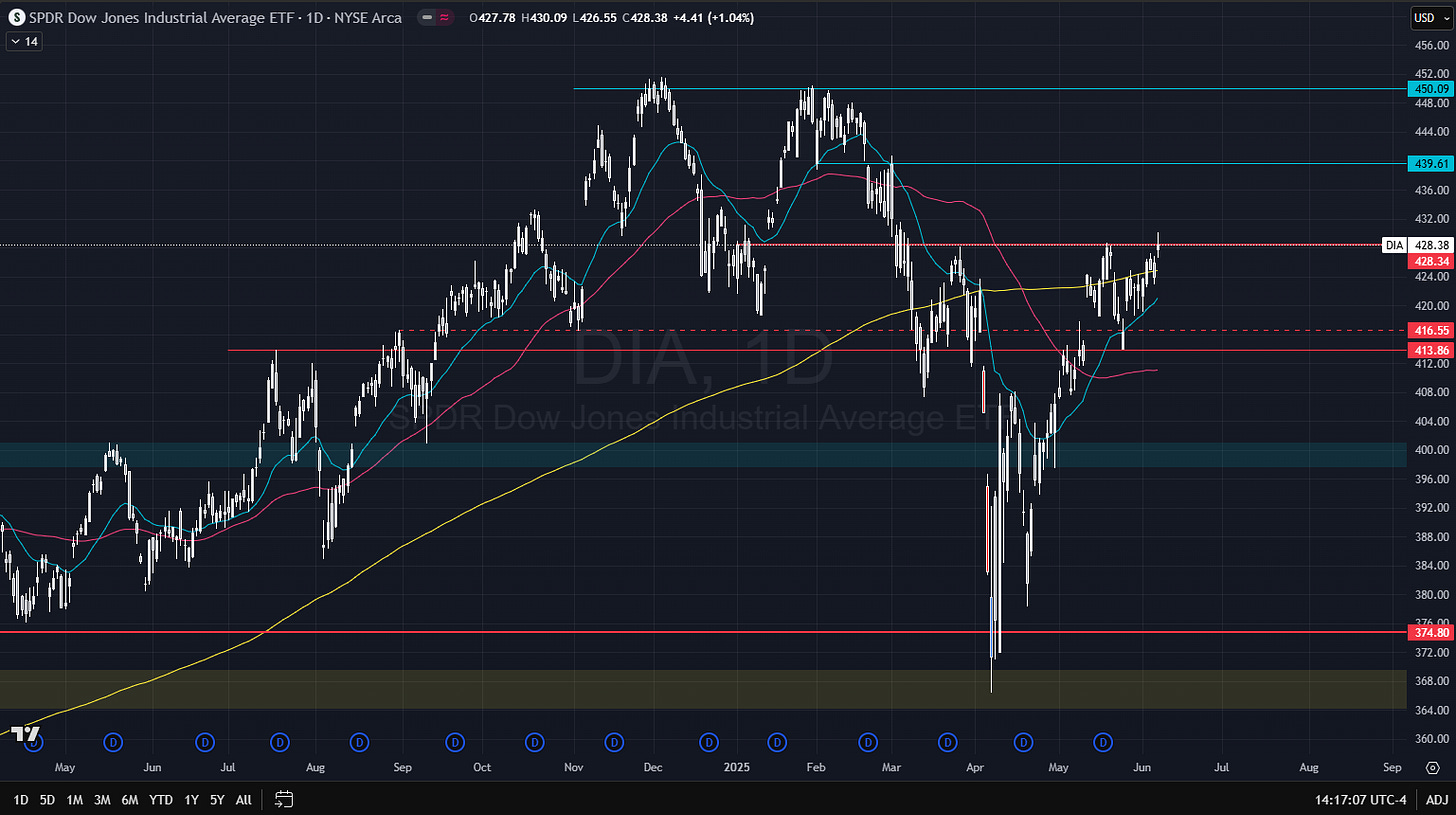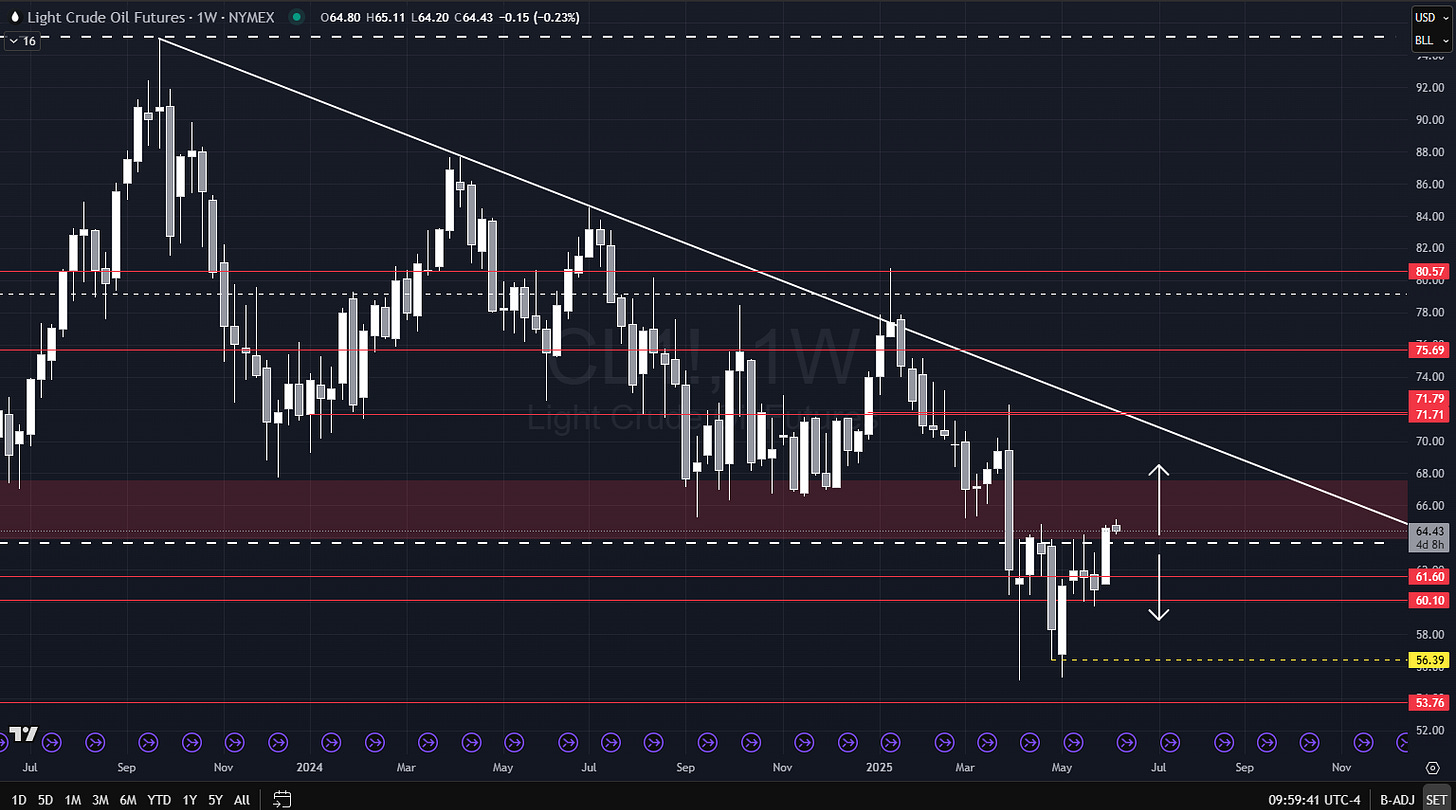Weekly Roadmap: A Recap, A Look Ahead, and What’s Driving Markets
Weekly Roadmap for 06/08-06/14
Before diving into this week’s market roadmap, it’s worth revisiting a memo we published earlier highlighting several tactical trade opportunities unfolding beneath the surface.
While major indices grind higher, dispersion is quietly expanding, and that’s creating high-conviction setups in overlooked names and under-positioned sectors.
Whether it’s a short squeeze brewing in small-caps, rotation into quantum tech, or strategic positioning around fiscal tailwinds and geopolitical pivots, we’re entering a stretch where nimble, thematic trades may outperform passive exposure.
Now let’s dive in…
This past week felt like a bit of a whirlwind. Geopolitics, economic data, and policy headlines all jostled for investor attention, yet markets took it in stride. Let's break it down and chart a clear course into the week ahead.
From Drone Strikes to Diplomatic Détente
Markets opened the week with a sharp dip following a drone strike in Russia linked to Ukraine, but true to form, the pullback was swiftly bought. The risk-off sentiment didn’t last long.
As the week progressed, sentiment improved, thanks in large part to a surprisingly cordial phone call between Trump and Xi Jinping. The conversation signaled further thawing in U.S.-China relations and helped ease geopolitical jitters.
But things didn’t stay calm for long… by midweek, headlines turned toward the brewing spat between Trump and Elon Musk. The disagreement? Trump wants to push forward his “Big Beautiful Bill,” while Elon is lobbying for a leaner, more fiscally conservative package. Politics aside, markets seemed unfazed.
To close out the week, Non-Farm Payrolls came in better than feared. That print helped power a late-week rally, with small caps leading the charge. The Russell 2000 (IWM) jumped +3%, with the Dow Jones, albeit more modestly, up 1.6%.
What’s on Deck: CPI + China Talks
Looking ahead, the calendar is relatively light, but what is on tap could move markets.
Monday: U.S. and China resume trade talks in London. Given the recent positive tone from both sides, this meeting could offer another signal that tensions are easing.
Wednesday: The main event, CPI data. Both headline and core inflation are expected to tick slightly higher compared to the previous month. While not dramatic, any upside surprise could shake the current “goldilocks” vibe.
Beyond that, expect summer trading conditions to kick in, lighter volumes and a possible volatility drift lower unless a macro shock intervenes.
Also worth noting: Trump confirmed that China will resume its rare earth mineral exports to the U.S., another sign that behind-the-scenes negotiations are progressing.
SPX Outlook: Technical Breakout or Fakeout?
The S&P 500 finally broke out of its month-long consolidation, closing just above the 6,000 level on Friday. The index struggled to hold that level during the session, but closed strong thanks to a cooler-than-feared jobs report.
Volume was light (as expected for this time of year), and that’ll likely continue into summer. But if CPI comes in tame and U.S.-China talks don’t derail, there's not much in the way of SPX grinding up toward the all-time high of 6,147.
The market’s thesis? The administration is shifting toward “running it hot”, a clear pivot toward fiscal stimulus and deregulation heading into the second half of 2025. As long as inflation remains manageable, this stance should continue to support risk assets.
That said, if 6,000 turns into firm resistance and the breakout fails, bears will be watching the yearly open of 5,900 level closely. That area has been a key support as it coincides with:
The EU-delay “bull gap”
The China tariff pause gap
The 200-day moving average
A break below 5,900 would likely open the door to a deeper pullback, but until then, the bulls remain in control.
Tech Tape: QQQ and the AI Trade
Let’s start with the Nasdaq 100 (QQQ).
Coming into last week, there were some nerves around a potential “news failure” after Nvidia’s stellar earnings the week prior failed to spark sustained upside. The initial rally in both Nvidia and the Qs faded quickly, but that hesitation didn’t last long. Instead of rolling over, the Qs regrouped and marched to new local highs, invalidating that weakness entirely.
Even the late-week political drama between Trump and Elon Musk, which briefly weighed on sentiment in the tech space, couldn’t derail the rally. By Friday, QQQ had reversed again, closing the week at the highs. In short: every perceived negative headline is getting bought, and that’s not bearish price action.
QQQ Technical Outlook
We’re now seeing the classic “summer drift” (slow, low-volume grind higher). The Qs are hovering just below the 530 level, which has become a stubborn resistance zone. A clean breakout above would open the door to 537, which marks the prior all-time highs from December and February.
On the downside, 515 is the key level to watch. That area was created by the EU bull-gap a few weeks ago and lines up with the rising 21-day moving average, adding technical confluence. If 515 holds, bulls remain in control.
Bigger picture, the long-term support zone sits around 500, near the China tariff-pause bull gap and the 200-day MA. As long as the Qs can base and build above that 496–501 range, the larger uptrend remains intact and dips are likely to stay shallow and buyable.
Risk Rotation: Small-Caps and the Return of Industrial Strength
Last week brought confirmation of something we’ve been watching closely: small-caps are waking up.
IWM: Small-Cap Rally Breaks Out
The Russell 2000 (IWM) was the best-performing major index last week, closing up just over 3%. What’s driving it? Two key forces:
Resilient hard data. The economy continues to beat expectations, and that’s fueling optimism under the surface.
Extremely light positioning. Allocations to small-caps are still hovering near their 2022 bear market lows, despite improving conditions.
Now combine that with tame inflation (so far), and what do you get? Goldilocks. That’s a sweet spot for small-cap outperformance. Sprinkle in the coming deregulation push from the administration into 2H '25 and ‘26, and the setup becomes even stronger.
IWM Technical Setup
Last week, IWM finally broke out of the downtrend it had been trapped in since late 2023. If that breakout holds, the index has a clear magnet up toward the 200-day moving average near 216, which will likely act as the next resistance.
If CPI comes in tame this week and soft data continues to rebound from April’s lows, we could see a catch-up rally toward 225 over the summer, especially as shorts unwind and small-caps play catch-up with large caps.
But if this breakout fails? Watch 200 as key support. That range aligns with 2024’s yearly open. A break below that level would signal fading momentum, but it likely requires a real shock: either a scorching-hot CPI print, weak economic data, or a sudden resurgence of tariff headlines.
As of now, the burden of proof is on the bears.
DIA: Industrials Wake Up
The Dow Jones (DIA) closed out the week up 1.6%, breaking out of a multi-week range and reclaiming the 200-day moving average. It also printed new local highs, a sign that the cyclical trade may be catching a second wind as hard data continues to hold up.
As long as this breakout sustains, there’s a clean path toward the all-time high at 450, which formed in March before the major pullback into April. That area should present initial resistance, but if cleared, new highs are in play.
On the flip side, if DIA loses 413 (recent local highs), the 50-day MA could offer support. IMO a downside case likely only plays out if economic data turns, or if tariff risks resurface ahead of the July deadline.
Macro Pulse: The Dollar, Inflation, and the Bond Market Crossroads
Jobs, CPI, and the Dollar: A Balancing Act
The U.S. dollar traded relatively flat last week, but the story under the surface was more interesting. To close out the week, Non-Farm Payrolls came in slightly better than expected:
+139K jobs added (vs. +125K est.)
Unemployment rate at 4.2% (in line)
One standout stat: for the first time in over two years, native-born workers accounted for all net job gains, a shift largely driven by the administration’s tightening of immigration policy. This reduced labor supply may keep unemployment anchored even if payroll growth slows, which is a structural shift worth monitoring into year-end.
In response to the data, the DXY (Dollar Index) posted a modest bounce on Friday but still closed the week flat.
CPI Ahead: Tariffs Begin to Show Up
This week, the spotlight turns to inflation. Wednesday’s CPI print is the first where we’ll likely start seeing tariffs filter into the data. Expectations:
Headline CPI: 2.5% (vs. 2.3% prior)
Core CPI: 2.9% (vs. 2.8% prior)
With year-over-year comps getting tougher, we believe inflation is likely bottoming, and the risk moving forward is a gradual reacceleration into late 2025 and 2026.
That said, most Fed officials have downplayed this risk, suggesting they’ll look through any short-term rise as a "one-time price shock." The Fed still has two cuts priced in for 2025, starting as early as September. But if CPI comes in soft again and growth data wobbles, the odds of a July cut could creep toward 50/50.
Dollar Outlook: Cautious Bull or Broken Trend?
The base case remains bearish over the longer term, as structural headwinds continue to weigh:
Fiscal dominance and deficit spending
Eroding U.S. trade leverage
Loss of credibility in global markets
The administration’s comfort with a weaker dollar (as long as it’s orderly)
Bottom line: the dollar is still in a downtrend, but a near-term bounce wouldn’t surprise me.
Bond Market: Rangebound, Reactive, and Getting Jittery
The bond market had a rollercoaster week and this coming week will likely provide another test.
Rates initially stayed bid, continuing a trend that began after Japan’s Ministry of Finance signaled a shift in issuance strategy, and the BOJ followed up by announcing plans to taper QT next year. These international developments provided relief as JGB volatility had been pressuring global yields.
But the stronger-than-expected jobs report on Friday changed the narrative again. As recession fears faded, yields popped and 10-year Treasuries rose back above 4.5%, retracing much of the week’s earlier bid.
Big Picture: Inflation Still the Sticking Point
As we’ve argued for weeks, hard data continues to beat the doom-and-gloom narrative and inflation is increasingly showing signs of entrenchment above 2%. Without a recession or serious austerity, it’s hard to envision the Fed fully nailing its 2% target.
Fiscal policy remains expansionary
The U.S. is running recession-level deficits during growth
The administration is explicitly pivoting to “run it hot”
That doesn’t mean inflation is about to explode, but it likely won’t vanish either.
Commodities Watch: Crude Oil Rises, Gold Pauses, and Inflation Risks Stir
Crude Oil: Building the Case for a Tighter Market
Oil finally showed some upward movement last week and while the big-picture structure hasn’t radically shifted, the foundation for a bullish thesis is quietly strengthening.
Earlier this year, WTI crude found support around the 2018 and 2020 highs, and that historical resistance has since turned into reliable support, helping to drive the current rebound off the mid-$50s.
What Changed This Week?
The big catalyst came from the supply side:
Baker Hughes rig count dropped sharply, now at its lowest level since 2021.
This collapse in rig activity suggests tightening U.S. supply is underway.
Combine that with capital discipline and OPEC+ maintaining production quotas, and the market may finally be shaking off the persistent Saudi-driven oversupply narrative.
TL;DR:
Falling rig count = falling future supply
If global demand holds or rises (summer travel, EM growth), oil has room to move higher
Add disciplined OPEC+ output, and you’ve got the makings of a tighter second-half market
Technical View: A Potential Base is Forming
Support Zone: $55–$57
Upside Range: $67.50–$72
Breakdown Risk: If economic growth slows or recession fears spike, a retest of $52–$51.50 could come into play
Gold: Tail Risks Fade, But Long-Term Support Still Holds
Gold saw some modest selling pressure last week as geopolitical tail risk eased, particularly after Trump’s positive phone call with Xi and progress in U.S.-China relations. As a result, the uncertainty premium faded, and we saw some rotation into other metals notably Platinum and Silver (which we flagged weeks ago).
That said, despite the consolidation, gold has held up remarkably well.
What’s Supporting Gold?
The U.S. still has a massive fiscal deficit
Inflation may not be dead, just dormant
Even as some of the panic bid deflates, gold’s macro case remains intact. I continue to believe dips will be bought, especially as fiscal spending ramps and the global monetary system looks increasingly fragile.
Wrapping It Up: Eyes Forward, Feet Grounded
Markets continue to climb a wall of disbelief.
Despite tariff noise, political drama, and a constantly shifting macro narrative, the hard data keeps holding, inflation remains mostly contained (for now), and price action refuses to break down. That tells us something: the market is running on resilience, not euphoria.
Positioning is still light, breadth is improving, and major indices are pressing through key resistance levels. Under the surface, small-caps are perking up, tech remains dominant (but rotational), and the commodities complex is stirring all against a backdrop of light summer volume and a global economy that’s refusing to roll over.
Here’s what matters right now:
CPI this week is the next test. It’s the first real read with tariffs filtering through, and comps are getting tougher. Inflation bottoming? Very possible. But as long as it’s controlled, the Fed seems willing to look through short-term spikes.
U.S.-China relations are warming. That removes tail risk and helps unlock upside in names that benefit from de-escalation and rerates some defensive trades like gold and the dollar.
Rate cut bets remain intact. September is still the baseline, but soft CPI + weak data could bring July into the conversation. Either way, the path forward still favors liquidity support.
Fiscal tailwinds are building. Trump’s “run it hot” pivot into deregulation, infrastructure, and stimulus will continue to underpin risk appetite especially heading into 2H ‘25 and beyond.
So yes… there are risks. There always are. But in this market, the pain trade is still up, not down. Dips continue to get bought. And while consensus stares at the ceiling, the market may just sneak out the window.
Stay tactical, stay adaptive, and above all stay ready.
-BSR
Disclaimer:
Remember, this is not financial advice. You are fully responsible for your own decisions!
The information provided on this website/Substack is for informational purposes only. While it is believed to be reliable, Blackshore Research does not guarantee its completeness or accuracy. This content is not an offer or solicitation to buy any financial instrument. The information and terms on these pages can change without notice. Unauthorized use of Blackshore Research’s websites and systems is strictly prohibited. This includes data scraping, unauthorized access, password misuse, or improper use of posted information. Your eligibility for certain services will be determined by Blackshore Research and its affiliates. Investment services are not FDIC-insured and carry investment risks, including potential loss of principal. The proprietary information from Blackshore Research or third-party providers is for individual use only and must not be redistributed or transferred without prior written consent from Blackshore Research.













